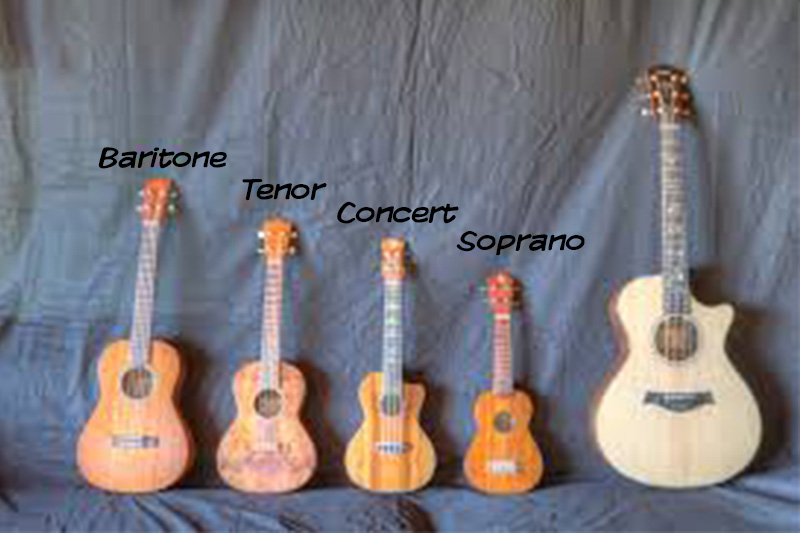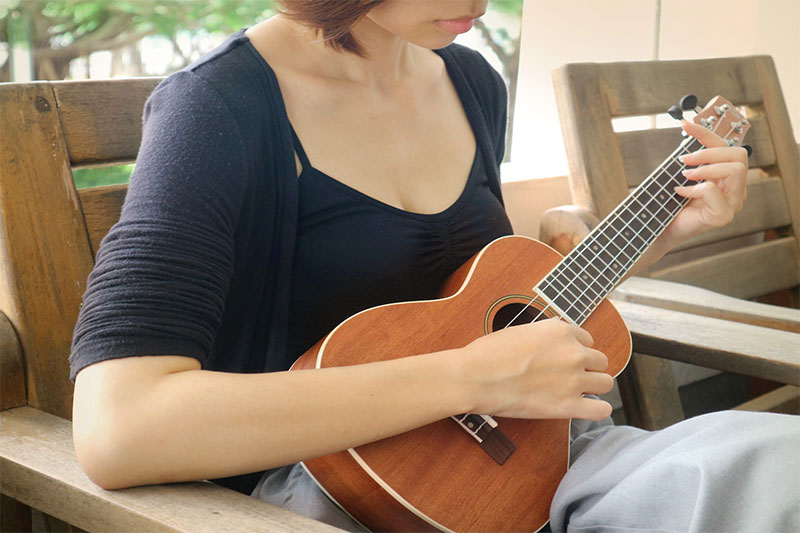The ukulele is a beautiful wooden stringed instrument that produces a unique sound that’s pleasant to the ears. Luckily for all of us ukulele players, there is a wide variety of ukuleles to play, coming in different sizes, wood types, and even ones that were designed for certain playing styles. With so many different types of ukuleles, it’s important to understand the differences between all of them so you can figure out which type of uke is best for your current needs. Whether you’re a beginner or an advanced player, we put together this guide to help you.
Table of Contents
The 4 Main Types of Ukuleles
Soprano
The Soprano Ukulele is the most traditional size ukulele, sizing at around 20 inches (51 cm). They are the smallest and lightest ukuleles of the main 4 types we are going to be discussing, having the shortest scale and the tightest fret spacing. Soprano ukes are easy to hold and are perfect for those who have smaller hands, however, there are some things you should keep in mind.
The overall smaller size and tighter neck present players with some limitations. The main one you will notice is that the higher you go up the fretboard, the more the tuning will begin to sound off. Soprano ukuleles are great for strumming chords, but not the best for picking notes.
They are known to produce a crisper, brighter, and softer tone with less projection and resonance than the other ukulele sizes, but overall are one of the most popular choices for ukulele players.
Is The Soprano Ukulele Best for You?
Soprano ukuleles are great for players of any skill/experience level but are especially good for younger players and those who have smaller hands and fingers. These are great entry-level ukuleles that produce a nice traditional sound.
You won’t have any problem strumming chords on this type of uke, however, like we already mentioned, they’re not the best for picking notes. If you plan to play the ukulele with a more technical style, we would definitely recommend looking at other types and sizes.
Concert

Photo credit: Kyla Duhamel on Visualhunt.com / CC BY
Concert ukuleles are a little bigger than soprano ukes, having a bigger body, a longer neck, and more versatility. You will find that concert ukuleles have a wider neck and weigh a little more too. This extra length that concert ukes provide allows for more frets with wider spacing between them.
Unlike Soprano Ukuleles, you won’t be as limited to just playing chords, allowing you to play notes as well. They intonate much better as you go higher up on the fretboard.
Concert ukuleles have a fuller sound that is warmer in tone and louder in volume. Their bigger bodies increase mid-range while also adding some bass.
Is The Concert Ukulele Best for You?
Concert ukuleles are great for players of any skill level, however, those with larger hands and fingers will find it more comfortable to play. Experienced players can appreciate concert ukuleles as they are more versatile to fit more playing styles. Many have also found that Concert ukes are great for performances, being an ideal size that makes it easy to hold without having to use a strap.
If you’re a little older, but just getting started on playing the ukulele, the Concert size ukes would be great to learn on. Overall, Concert ukuleles have an excellent balance in terms of sound and playability, making it a favorite choice for many ukulele players.
Tenor
A size bigger from concert ukes, we have the Tenor ukulele. Tenor ukuleles are bigger in size, with a scale that is about two inches longer than concert ukes. There’s a noticeable weight difference when going from a Concert uke to a tenor ukulele. Their necks are wider and longer than the previous ukulele sizes we’ve already discussed. Of course with the extra length and wider spacing between the frets, Tenor ukuleles are excellent for fingerpicking styles of playing, putting fewer limitations on players.
Because of their size, Tenor ukuleles produce a deeper, fuller sound with a resonant that has bass characteristics in the overall tone. They project louder than concert ukuleles while still having a natural sound, both when strumming chords and picking notes on the scale.
Low G String
You can also change the G string on a Tenor ukulele to a low G, something we’d definitely recommend as it can give your instrument more range. When playing any type of scale on a ukulele with a high G string, you will find that it sounds a little awkward as the sound jumps higher when you get to that fourth string. With the low G, playing a scale will sound more natural.
While having a low G does extend the range of the instrument, you won’t have the traditional ukulele sound because of the “bassier” tone. Both the high G and low G are great, producing a different sound that will fit different playing styles. We definitely recommend you have both in your ukulele arsenal, however, if you can only have one, the deciding factor will be your playing style and musical preference.
Above is an excellent video that explains this in more detail from the YouTube channel, Uke Like The Pros
Is The Tenor Ukulele Best for You?
Tenor sized ukuleles are very popular among professional players, however, they’re still great for anyone, especially if you’re looking for an overall fuller and deeper sound. Their larger size makes them perfect for players with bigger hands and for those who do a lot of fingerpicking styled playing with their ukuleles.
Like we mentioned, you do have the option of having either a high G or a low G with your Tenor ukulele, giving players more options, versatility, and range.
Keep in mind that the tuning for tenor ukuleles is the standard G/C/E/A, and that the wider spacing on the fretboard may make it a little more difficult to play chords that require a stretch.
Baritone

Image by hjroh88 from Pixabay
The last uke size we are going to discuss is the Baritone ukulele. Baritone ukuleles have the longest scale, around three inches longer than the tenor’s scale. They have the widest fret spacing available when compared to all of the other sizes of ukes. Players will also find the neck on baritones to be wider than any of the other sizes.
Baritone ukuleles have the deepest and fullest sound with the most low end, coming across as more bassy. The sound is similar to what an acoustic guitar would produce. The similarities don’t end there, as baritones standard tuning would be D/G/B/E. This is similar to the four highest strings on a guitar.
Is The Baritone Ukulele Best for You?
If you’re already a guitarist, it can be easiest to transition to playing the ukulele with a baritone uke. This also works the other way around. If you’re planning to learn how to play the ukulele as a way to transition into playing the guitar, it might be best to play with a Baritone uke. With a similar tuning to a standard guitar and a bigger size to play with, it’s a good ukulele that can make the transition to play guitars much easier.
If you’re planning to stick with the ukulele as your primary instrument, we would definitely recommend looking at the other 3 sizes we already discussed.
Different Types of Wood
Now that you know about the main types of ukuleles to look at, it’s time to talk about the wood that makes them. There’s a lot of different models of ukuleles that are built with different types of woods. Instead of going through all of the different types of wood variations that you will find from ukuleles, we are going to discuss the most commonly used ones.
Mahogany
Probably one of the most popular woods to use to build a ukulele is Mahogany. Ukuleles made out of Mahogany are known to have a well-balanced tone between the high treble notes and low bass notes, overall producing a classic traditional ukulele sound. Mahogany wood instruments really shine in the midrange tones, producing a punchier sound compared to other woods. It’s hardwood so expect it to feel slightly heavier and denser.
Koa
A popular wood choice, especially if the ukulele is made in Hawaii. Koa ukuleles have a more direct sound with good sustain. Just like Mahogany, Koa has a very nice tone overall but shines with its midrange. Koa ukuleles are also really nice aesthetically, having a nice attractive body that’s clean and slick. A definite popular choice amongst many ukulele players of all skill levels.
Spruce
Spruce is a very strong softwood that produces a crisp and vibrant sound. It has a warm tone that’s dominant in the mids and lower register. They have a lot of bass response and its note articulation is consistent. The pale yellow color of the wood really makes a ukulele stand out when compared to other woods. Overall, Spruce ukuleles excel across a range of frequencies and are a popular choice for dynamic strummers.
Maple
Maple ukuleles are known for their clarity and their distinct treble sound. They help make very durable ukuleles that are usually paired with spruce. Now, they don’t resonate as much as other woods and sustain wouldn’t be one of their strengths, but Maple ukuleles are great for certain styles where individual clarity of notes is the priority (fingerstyle of playing). Overall, Maple ukuleles produce a bright sound and look gorgeous aesthetically.
Rosewood
A wood you don’t often see in the world of ukulele, however, you will be impressed by the good balance of mid-range and low tones, plus the accentuated highs that Rosewood can produce. It is commonly known to be used for the fretboards of ukuleles, however, you can find ukes that are fully built out of Rosewood. It’s a very popular choice for the back and sides of wooden instruments such as ukuleles and guitars, helping produce resonating tones that are warmer.
Laminate or Solid Wood?
Laminate
Laminated ukuleles are great for children as they are less expensive, more durable, and easier to clean/maintain. They’re also great for travel thanks to the durability that comes with a laminated uke. The sound might not be as natural as a solid wood ukulele, however, they are still great instruments for any type of player.
Solid Wood
A solid wood ukulele has an unbeatable sound and an incomparable tone. If you’re looking to produce the most natural sound from your uke, definitely consider a solid wood ukulele. They are more expensive then their laminated counterparts, however, if you have the money, they are well worth the investment.
Also, if properly taken care of, solid wood ukuleles can develop a richer and resonant tone the more it’s played over a long period of time.
Ukulele String Types
There are a lot of different types of strings to choose from, each producing a different type of sound and tone. If you are looking to buy some new strings check out our guide here: The 8 Best Ukulele Strings 2019 (FULL BUYERS GUIDE)

Nylon
The most commonly used types of strings on a ukulele are Nylon. There are so many different types of nylon strings that result in different sounds. Keep this in mind as the sound of nylon ukulele strings can vary from brand to brand.
Nylon strings stretch over time, meaning you might be finding yourself tuning your ukulele more often. Certain temperatures cause the strings to stretch more but they won’t be affected by humidity.
Fluorocarbon
Fluorocarbon strings are made of polymer and were originally developed for use in fishing lines. They offer a slightly brighter sound and are less affected by temperature changes.
Titanium
Titanium ukulele strings offer more strength, durability, and a slightly brighter tone than nylon. This is all thanks to the monofilament material that these type of strings are made of. They project more sound at a higher level volume.
Wound Nylon
Wound Nylon strings have a nylon core that is wrapped with a polymer winding material. They are usually used with tenor and baritone ukulele as the two lower strings. Keep in mind that these strings are prone to producing finger squeaks as you slide from fret to fret.
(Cutting wound strings to length may ruin it if the wrapping material starts separating from the core.)
Wound Metal
Similar to wound nylon strings, wound metal strings are usually used on lower notes and larger sized ukuleles. They are commonly composed of winding materials that are copper or aluminum. Again, keep in mind that they are prone to producing finger squeaks.
(Cutting wound strings to length may ruin it if the wrapping material starts separating from the core.)
Steel Strings
Stringing your ukulele with steel strings may not be the best idea. Steel strings add additional tension that exerts on the top, bridge, and neck of the ukulele.
Of course, there are a few instruments that utilize steel strings such as banjoleles, guitars/ukuleles that are built for them, and dobro/uke hybrids.
It may be best to consult a professional before replacing your ukulele’s strings with a steel set.
Final Thoughts
The ukulele is such a fun instrument to learn and play. Hopefully, our article has made you more knowledgeable in this instrument, allowing you to figure out and pick the best type of ukulele for your current needs. With such a wide variety of different types of ukuleles available nowadays, you will be able to find the perfect uke for you as long as understand what you are looking for. Best of luck on your ukulele journey!





Leave a Comment